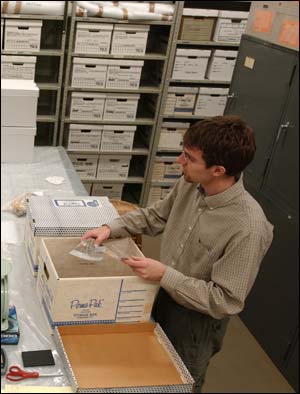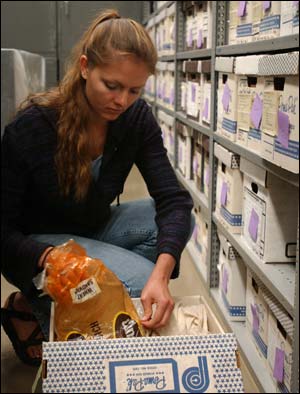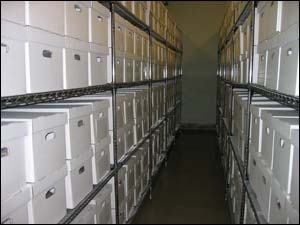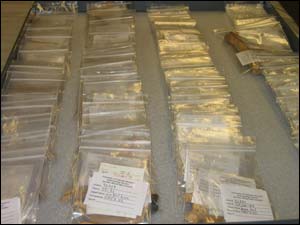The Yellow Jacket Artifact Collections
The artifact collections from sites 5MT1, 2, and 3 represent an archaeological assemblage with tremendous research potential. It is one of the largest collections from a single locale of the American Southwest and represents the results of a research effort that spanned 21 field seasons. Yet, the Yellow Jacket collections from the Joe Ben Wheat site complex are a scientific resource with a largely untapped research potential due to limited artifact analysis.
The Yellow Jacket sites collections are comprised of about 18,000 artifact lots that include close to 300,000 artifacts. All of the major artifact categories are represented: ceramic sherds (45%), whole ceramic vessels (<1%) a variety of groundstone tool types (18%), chipped stone tools and debitage (25%), archaeological samples (5%), nonhuman bone and bone tools (2%), and a variety of other artifact types (5%). The sample size of all of these artifact types from most proveniences is large enough to produce statistically significant and archaeologically meaningful results for a variety of research questions. Site reports have been produced for 5MT1, 5MT2, and 5MT3 that suggest some potentially productive research themes for each site assemblage.
Research Potential
The Yellow Jacket collections have only recently become available for general research use. As of 2005, most artifact categories have not been comprehensively analyzed. The portions of the collection which have been studied so far are mainly reported in unpublished student projects and a small number of MA and PhD theses. The relevant publications for each site are discussed in the "Overview" section of each site report. There is tremendous research potential for systematic artifact or detailed site analysis, as well as for synthetic investigations of the Yellow Jacket sites. These collections look very promising as a source for a number of papers and theses each year for the foreseeable future. Anthropology and Archaeology undergraduate and graduate students are especially encouraged to utilize the Yellow Jacket collections for research leading to publishable papers or theses. There are also several more complex issues that could best be addressed by PhD students in several strong dissertation topics.
Museum staff can accommodate a variety of research requests, including initial database queries, visits to the collection, and short-term research loans. Contact the Anthropology Collections Manger with these requests.
Yellow Jacket Project Collections Revitalization
One of the primary motivators for the Yellow Jacket Project was the need to make the collections more user-friendly and accessible for researchers, students, faculty, and staff. Artifacts were dealt with on a year-to-year basis after each field season and were not reviewed from a comprehensive curatorial or museological perspective. The collections were stored in a wide variety of non-archival boxes and bags in several different areas in the museum. Many artifacts were not labeled and some had never been accessioned or catalogued. There were a variety of organizational systems and no database with artifact information had been created. This situation impeded the research process and discouraged people from utilizing this important scientific resource.
 |  | |
Before: The collections staff sorts and rebags the artifacts. Note the variety of non-archival storage materials on the shelves. | Before: Many artifact lots were stored in the original packing material from the field, which included cigar and band-aid containers, liquor boxes, and bread bags. A top priority was transferring all the artifacts into polyethylene plastic bags and producing new artifact labels with acid free paper and archival ink. |
To reduce or eliminate these concerns, and to encourage people to make more frequent use of the collections, the Museum completed the following collections management and conservation tasks between March 2004 and March 2005:
- All Yellow Jacket collections have been consolidated into one storage room in 651 archival boxes and 6 Lane Cases.
- Artifact storage facilities have been reorganized and new Metro shelving units have been installed.
- All artifacts and artifact lots have been sorted and placed individually into archival quality polyethylene bags with new artifact data labels made with archival-quality paper and ink.
- All artifacts and artifact lots have been reorganized and resorted into new boxes and organized by artifact type, provenience, and catalogue number.
- All uncatalogued artifacts from the Yellow Jacket sites with archaeological value have been formally accessioned and catalogued.
- A relational database for collections information has been created in MS Access. Artifact and provenience information for about 90% of the collection (close to 16,000 entries) has been entered into this database. Over the next several years (2005-2008), data will be entered for the remaining artifacts, separate artifact and provenience data sets will be merged, and these data will be imported into Re:Discovery museum database software.
Some additional collections work remains to be done and will be completed in the next several years by Museum staff, students, and volunteers. However, as of spring 2005 the collection is fully reorganized, rehoused, databased, and ready to be used for research, teaching, and exhibition.
 |  | |
After: New shelving, a completely new arrangement for the storage room, and archival quality boxes make the collection much more organized and uniform in its appearance. The information for all the artifacts in every box was also entered into a database. | After: Artifacts were labeled and individually bagged by catalogue number using archival storage materials. This system results in the ability to much more quickly find specific artifacts. |
